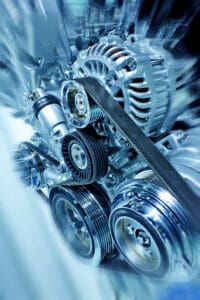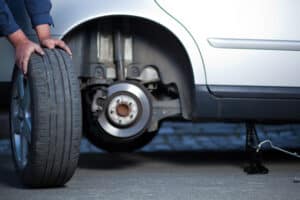As the recent long, drawn-out winter of Idaho Falls finally surrenders to the warmth of summer, residents eagerly embrace the opportunity to bask in the sun, embark on outdoor adventures, and enjoy the natural beauty that surrounds their vibrant city. However, the transition from icy roads to sun-drenched highways brings its own set of challenges.
As your local auto body shop in Idaho Falls, we aim not only for Idaho Falls body repair but also to equip our local residents with the necessary knowledge to navigate the summer roads safely and avoid damage to person and property. In this blog post, we will explore essential summer driving safety tips tailored specifically for our community, where the summers are short, hot, and beckon us to seize every moment of the season. While significantly safer than winter driving, there are some safety tips you should still keep in mind.
Essential Summer Driving Tips for Idaho Falls Residents
Keep Your Engine Cool
 When the summer heat intensifies, keeping your engine cool becomes crucial to avoid the risk of overheating and potential breakdowns. Here are some essential tips to help you maintain optimal engine temperature during the scorching Idaho Falls summers:
When the summer heat intensifies, keeping your engine cool becomes crucial to avoid the risk of overheating and potential breakdowns. Here are some essential tips to help you maintain optimal engine temperature during the scorching Idaho Falls summers:
- Check Coolant Levels: Regularly inspect the coolant levels in your vehicle’s radiator to ensure they are within the recommended range. The coolant, also known as antifreeze, helps regulate engine temperature by dissipating heat. If the coolant level is low, top it up with a mixture of equal parts coolant and distilled water. However, exercise caution and wait until the engine cools down before removing the radiator cap to avoid injuries from hot steam.
- Inspect the Radiator and Hoses: Examine the radiator for any signs of damage, such as leaks, cracks, or corrosion. A compromised radiator can lead to insufficient cooling and potential overheating. Additionally, inspect the radiator hoses for cracks, bulges, or leaks. Replace any damaged hoses promptly to prevent coolant loss and engine overheating.
- Clean the Radiator and Condenser: Over time, dirt, debris, and bugs can accumulate on the radiator and condenser, hindering proper airflow. Regularly clean these components using a soft brush or compressed air. Ensure the engine is off and cool before attempting any cleaning. Removing debris allows for improved airflow, enhancing the cooling efficiency of your engine.
- Check the Cooling Fan: The cooling fan plays a crucial role in maintaining proper engine temperature. Inspect the fan blades for any damage or signs of wear. Turn on your vehicle’s air conditioning while the engine is running, and observe if the cooling fan engages. If the fan fails to operate or shows signs of malfunction, have it inspected by a qualified technician.
- Monitor Temperature Gauge and Warning Lights: Pay attention to the temperature gauge on your dashboard while driving. If you notice the gauge indicating an unusually high temperature or if a warning light illuminates, pull over safely and turn off the engine immediately. Continuing to drive with an overheating engine can cause severe damage. Allow the engine to cool down before assessing the issue or contacting a professional for assistance.
- Schedule Regular Maintenance: To ensure your engine remains in optimal condition, adhere to regular vehicle maintenance intervals. This includes regular oil changes, as clean oil helps dissipate heat more efficiently. Additionally, have a professional inspect your vehicle’s cooling system during routine maintenance to identify any potential issues early on.
Check the Tires
 When driving in the scorching summer heat of Idaho Falls, it is crucial to prioritize the condition and maintenance of your vehicle’s tires. The hot pavement and increased temperatures can have a significant impact on tire performance and safety. Here are some essential tips to help you keep your tires in optimal condition during the summer months:
When driving in the scorching summer heat of Idaho Falls, it is crucial to prioritize the condition and maintenance of your vehicle’s tires. The hot pavement and increased temperatures can have a significant impact on tire performance and safety. Here are some essential tips to help you keep your tires in optimal condition during the summer months:
- Check Tire Pressure: As temperatures rise, tire pressure tends to increase. It is important to regularly check your tire pressure using a reliable tire gauge. Refer to your vehicle’s manual or the placard usually located on the driver’s side door jamb for the recommended tire pressure. Ensure that all tires, including the spare, are properly inflated. Under-inflated tires can lead to reduced fuel efficiency, poor handling, and increased risk of tire failure.
- Inspect Tread Depth: Adequate tire tread depth is crucial for maintaining traction on hot roads. Inspect your tires regularly for signs of wear and ensure they have sufficient tread depth. You can use the “penny test” to check tread depth by inserting a penny into the tread grooves with Lincoln’s head facing down. If the top of Lincoln’s head is visible, it is a sign that your tire tread is too shallow, and it may be time for tire replacement.
- Look for Signs of Damage: Examine your tires for any visible signs of damage, such as cuts, bulges, or sidewall cracks. High temperatures can exacerbate existing tire damage and increase the risk of tire blowouts. If you notice any abnormalities or suspect tire damage, have them inspected by a professional. It is better to address tire issues proactively rather than risking a sudden tire failure while driving.
- Rotate and Balance Tires: Regular tire rotation and balancing are essential for promoting even wear and extending the overall life of your tires. Consult your vehicle’s manual or follow the recommended tire rotation schedule provided by the tire manufacturer. Properly balanced tires contribute to smoother and more stable driving, reducing the chances of uneven tread wear.
- Maintain Proper Wheel Alignment: Hot summer roads combined with potholes and rough surfaces can impact your vehicle’s wheel alignment. Misaligned wheels can cause uneven tire wear, decreased fuel efficiency, and compromised handling. If you notice your vehicle pulling to one side or experience vibrations while driving, have a professional check and adjust the wheel alignment if necessary.
- Consider Summer Tires: Depending on your driving needs and the specific climate in Idaho Falls, you may want to consider using summer tires. Summer tires are designed with specialized rubber compounds and tread patterns to provide improved traction and handling in hot weather conditions. They can enhance performance and safety during the summer months.
Monitor Fluid Levels
 Engine Oil: Regularly check the engine oil level using the dipstick, following the manufacturer’s instructions. Low oil levels or dirty oil can lead to engine damage and decreased lubrication, especially in high temperatures. If the oil appears dark or dirty, it may be time for an oil change. Make sure to use the recommended oil viscosity for your vehicle.
Engine Oil: Regularly check the engine oil level using the dipstick, following the manufacturer’s instructions. Low oil levels or dirty oil can lead to engine damage and decreased lubrication, especially in high temperatures. If the oil appears dark or dirty, it may be time for an oil change. Make sure to use the recommended oil viscosity for your vehicle.- Coolant/Antifreeze: Check the coolant level in the coolant reservoir when the engine is cool. Ensure it reaches the recommended level and inspect the coolant’s color—typically either green, red, or yellow. If the coolant appears discolored or contaminated, it may require flushing and replacement.
- Transmission Fluid: Proper transmission fluid levels contribute to smooth gear shifting and overall transmission performance. Check the transmission fluid using the dipstick when the engine is warm and idling. If the fluid level is low, consult your vehicle’s manual for the correct type of transmission fluid to add. However, if the fluid appears dark or has a burnt smell, it may indicate the need for a transmission fluid change or professional inspection.
- Brake Fluid: Brake fluid plays a critical role in ensuring effective braking. Inspect the brake fluid level in the reservoir and ensure it falls within the recommended range. If the fluid is below the minimum level, it could indicate a leak in the brake system, which should be addressed promptly. Brake fluid should be clear or slightly yellowish; if it appears dark or contaminated, it may require replacement.
- Power Steering Fluid: Power steering fluid allows for smooth and effortless steering control. Check the power steering fluid level according to the vehicle’s manual. If the level is low, add the recommended fluid type to bring it up to the proper level. Additionally, keep an eye out for any signs of leaks or unusual noises while turning the steering wheel, as these could indicate a power steering system issue.
Maintain the Air Conditioning System
 Test the AC System: Before the summer heat sets in, test your AC system to ensure it is cooling effectively. Start the engine and set the AC to its coldest setting. Check if the air blowing from the vents is cool and refreshing. If the air feels warm or the cooling seems inadequate, it may indicate a problem with the AC system that requires professional attention.
Test the AC System: Before the summer heat sets in, test your AC system to ensure it is cooling effectively. Start the engine and set the AC to its coldest setting. Check if the air blowing from the vents is cool and refreshing. If the air feels warm or the cooling seems inadequate, it may indicate a problem with the AC system that requires professional attention.- Clean or Replace Cabin Air Filters: Cabin air filters help remove dust, pollen, and other contaminants from the air entering your vehicle’s interior. Over time, these filters can become clogged, affecting the efficiency of your AC system. Check your vehicle’s manual for the location of the cabin air filter and inspect it. If the filter is dirty or clogged, clean or replace it as recommended by the manufacturer.
- Regularly Clean AC Vents: Dust, debris, and particles can accumulate in the AC vents, reducing airflow and affecting cooling performance. Use a soft brush or a can of compressed air to gently clean the vents and remove any obstructions. This will help ensure optimal airflow and more efficient cooling.
- Address Unusual Noises or Odors: If you notice any strange noises, such as rattling or squealing, coming from your AC system, or if there are unpleasant odors when the AC is running, it may indicate a problem. These issues could be caused by a malfunctioning compressor, a refrigerant leak, or mold and bacteria growth in the system. In such cases, it is advisable to have your AC system inspected by a qualified technician.
- Schedule Regular AC System Maintenance: Consider including AC system maintenance in your regular vehicle maintenance routine. Professional inspections and servicing of the AC system can help identify potential issues before they escalate, ensuring optimal performance throughout the summer. Experts can check refrigerant levels, inspect hoses and connections, and perform any necessary repairs or refrigerant recharges.
- Park in Shaded Areas or Use Sunshades: Whenever possible, park your vehicle in shaded areas to minimize heat buildup inside the cabin. If shade is unavailable, use sunshades on the windshield and windows to reduce the temperature inside the vehicle and lessen the strain on the AC system.
By following these AC system maintenance tips, you can enjoy a consistently cool and refreshing driving experience even during the hottest days of summer in Idaho Falls. If you encounter any persistent AC problems or if you are unsure about performing maintenance tasks yourself, it is advisable to seek professional assistance from a qualified automotive technician. Remember, a well-maintained AC system enhances your comfort and overall driving enjoyment during the summer heat.

